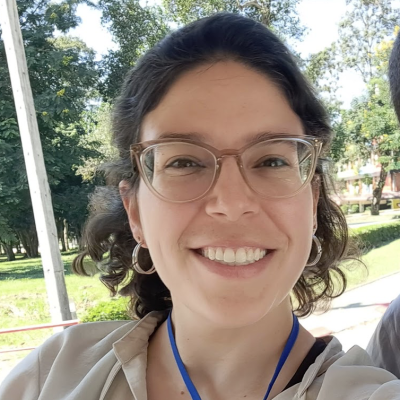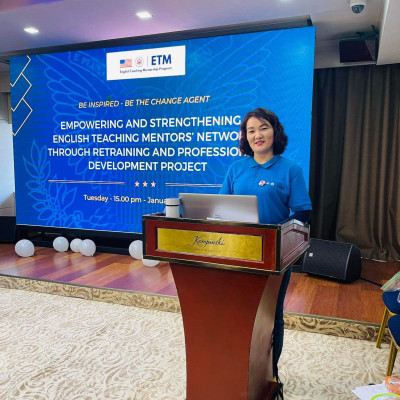Sessions / School
Page-Turner Practices: Practical, Captivating Approaches to Engage Readers #4395
We will show how Xreading and reading clubs have benefited students and how diversifying activities lead to student engagement and material retention. We will then break out into four small groups, each led by a co-presenter, to share activities involving different life skills and subjects. Attendees will rotate through each fifteen-minute station. In one group, participants work together to answer trivia questions to solve a letter cipher and decode story titles. They will then match the titles and characters descriptions to the correct stories. In another group, participants will read a short story and then the reading will disappear. Exercising their reading comprehension and imagination, the participants will recall and draw a specific character from the reading. Afterwards, presenters and participants will discuss the workshop activities; how they can be implemented in different classrooms and with different leveled students.
Cancelled How Can Extensive Reading Help Public School Students Improve Their Grades #4399
Since 2023, I have implemented an extensive reading program for newly enrolled sixth - graders. A year later, Shanghai began its new curriculum reform. This presentation highlights a personally - devised 10 - Tier Reading System in a Chinese public school, where the students are aged 11 - 12. The system started with the traditional Chinese comic story Journey to the West (Lexile ~ 350L) and advanced to novels such as Frindle. After one year, it has yielded significant outcomes: an average reading volume of 200,000 words per year (with the word count recorded in their reading logs) and a 38% growth in vocabulary knowledge (measured by a vocabulary test app). Combined with ER and the newly-reformed text books, this system has effectively transformed some struggling readers into more confident ones.
Impact of Extensive Reading on TOEFL Scores: An Indonesian Case #4066
Extensive reading (ER) has been documented as a beneficial activity that contributes to the improvement of learners’ English proficiency and reading skills. However, very little research reported the impact of ER on young avid reader’s TOEFL scores. In this talk, I will present my qualitative case study research with a young female avid reader (age 13 and year 9 student) who got a 560 score (58 for structure & written expression; 51 for reading comprehension) of the TOEFL ITP test. Through in-depth two interviews and observation, I found that the prolonged engagement with ER activities since year 3 (from 2016-present) by reading English fiction novels and online Japanese manga has developed her vocabulary mastery, reading skills, and implicit knowledge, which eventually facilitates her to get good scores on the section of structure & written expression and reading comprehension test. This study implies the long-term ER benefits for high-stake test scores with EFL learners.
Cancelled Power of SIRT and Reading Interest: Elevating Students’ Comprehension #4087
Reading comprehension remains below average among Indonesian students, as reported in the National Literacy Movement Report (2022), emphasizing the need for improved independent reading skills. Supported Independent Reading Time (SIRT), a structured reading program designed to foster student autonomy, offers a potential solution. This factorial experimental study investigated the effects of SIRT and reading interest on reading comprehension. Forty tenth-grade students from SMA Dharma Bhakti Palembang were assigned to experimental and control groups, categorized further by high and low reading interest levels. Data were collected through pre-test, post-tests, and questionnaires. Results indicated significant improvement in reading comprehension (mean = 11.95) and an essential difference between groups (t = 11.89, p <.001). A partial interaction effect was found between SIRT and reading interest on inference (p =.029) and vocabulary (p =.041), suggesting SIRT’s influence varies across reading comprehension. These findings provide insights for educators to enhance independent reading strategies.
Activities using Graded Readers for Grade 7 and Grade 10 #4400
In Japanese schools, English classes are expected to be taught using textbooks then graded using tests. Although ER is accepted as a method for language learning, many stakeholders expect lectures rather than silent reading during class. Thus, activities designed around books will meet the requirements from stakeholders. In this presentation, two activities will be explained. One for novice learners which focus on the vocabulary in the book. The lesson includes learning the vocabulary, creative writing using the words learned, followed by a short presentation. For intermediate learners, using the Canterville Ghost, students work in small groups to understand the story and discuss the cultural differences between the UK and the US. It is then followed by a short research presentation related to the cultural aspects from the book. The presentations can be graded using a rubric, which can be an alternative to paper tests.
Launching an ER Program at Part-Time Night School Without Xreading #4403
Many educators advocate for incorporating Xreading, a well-designed program that facilitates extensive reading instruction. However, despite its reasonable cost, some schools cannot afford it due to budget constraints. In such cases, teachers must find alternative solutions. This presentation discusses how an extensive reading program was implemented in a part-time night school, an institution that operates in the evening and generally has smaller class sizes than regular daytime schools. Students attend night school for various reasons, such as discomfort in large groups or past difficulties with compulsory education. However, one of the main challenges in night schools is their limited funding. This study explores how extensive reading was introduced in such a setting despite financial restrictions and examines its impact on students' engagement and learning outcomes.
Enhancing Students’ Interest and Management Skills in Extensive Reading #4408
This poster presents strategies for engaging a diverse group of 80 students with different English proficiency levels in extensive reading. It explores how motivation influences students' reading habits, book preferences, and overall confidence in language learning. Interactive activities, such as role-playing and poster-making, have been integrated into the program to foster active participation. Through acting performances, students improve their speaking, comprehension, pronunciation, and teamwork skills. These techniques make learning more enjoyable and effective, especially for young beginners. As a result, many students have developed a daily reading habit and sustained practice, leading to noticeable progress in their language skills. By fostering interest and engagement, these approaches not only help students improve their English but also empower them to become lifelong readers and future leaders. This presentation highlights practical ways to create an engaging extensive reading experience that encourages continuous learning.
Effective Actions Bridge the Gaps Between Policy & Practice #4394
Since the late 1990s, the acquisition of foreign languages—particularly English—has garnered significant attention both globally and within the Mongolian educational context. Despite this growing interest, achieving successful outcomes in English language learning remains challenging and, at times, stressful, often resulting in limited progress. In Mongolia, the need for effective English language teaching and learning strategies has become increasingly urgent. While national policies outline clear expectations for English proficiency, classroom realities often reveal a gap between these standards and practical implementation. Many students lack access to tools that facilitate the active use of English, including vocabulary development and reading practice. This paper explores effective practices in Extensive Reading (ER) activities that align with standardized English instruction. It argues that digital platforms such as Xreading.com play a vital role in bridging the gap between policy goals and classroom practices.
The First Year of an ER School in China: Design, Implementation and Progress #4065
This presentation aims to share insights from the establishment and operation of an extensive reading school in China, focusing on curriculum design and student engagement strategies. Through a series of regular and short courses, tailored reading plans, and ongoing feedback mechanisms, the program addressed diverse learner needs—from young beginners to exam-focused older students. Findings revealed that structured yet flexible ER plans, coupled with consistent feedback for students and parents, significantly improved reading engagement and reading ability across age groups. Younger learners developed language foundations through guided reading, and older students balanced ER with exam prep through strategically curated texts. The program’s progress highlights the importance of adaptable curricula, personalized tracking, and interactive incentives in sustaining motivation. Practical takeaways will equip educators to implement ER effectively in varied contexts, emphasizing scalability and learner-centered design.
Regression Analysis of Longitudinal ER on Writing Fluency in High School #4115
Extensive reading (ER) often requires years to give students sufficient text exposure. However, maintaining student engagement over such a long period is challenging. As a result, studies extending beyond a year are rare. Keeping students motivated is crucial, and providing opportunities to recognize progress can help sustain engagement. This study explores the relationship between two years of reading volume and a one-year academic writing course in a Japanese high school. Using regression models, this study examines trends over time and shows that reading amount significantly predicts words written. This prediction enables learners to set small goals for progressing in reading, fostering improvements in writing fluency. Celebrating small successes supports long-term language development. While this study highlights the link between ER and written word count, future research should examine accuracy and language use to further reinforce the reading-writing connection.
Supporting Students' Reading Skills in Rural Areas with E-Library Resources #4421
In rural areas, students face significant challenges in developing their English language skills due to limited opportunities for participation in extracurricular programs, clubs, and circles. These constraints restrict their ability to engage in additional learning and growth. However, the X-Reading e-library provides a valuable solution by offering a platform that allows students to improve their English skills at their own pace. This digital library gives students access to books tailored to their language level and personal interests, fostering a love of reading while enhancing comprehension and vocabulary. Furthermore, the platform encourages active involvement from parents and guardians, enabling them to track their child’s progress and support their learning journey. By integrating the X-Reading e-library into rural education, students gain the opportunity to develop their English language skills independently, fostering more equitable learning opportunities and promoting lifelong learning.
Empowering Young Learners Through ER: The DEAR Library Project #4149
With English returning to the Indonesia's primary school curriculum in 2027, early exposure to English texts is essential. However, many schools, including Bopkri Gondolayu Yogyakarta Primary School, have limited access to English reading materials, restricting students’ opportunities to develop reading skills. The lack of extensive reading resources in school libraries further complicates English teachers’ efforts to integrate reading into lessons. To address this, the English Language Education and Product Design Study Programs of Universitas Kristen Duta Wacana Yogyakarta have collaborated to establish the Drop Everything and Read (DEAR) English Reading Corner at Bopkri Gondolayu’s library. This initiative provides 50 leveled readers, organized on specially designed shelves according to the seven virtues of Kurikulum Merdeka, the Freedom Curriculum. The program aims to (1) enhance students’ exposure to English texts, (2) cultivate a habit of extensive reading, and (3) assist teachers in incorporating leveled readers into English instruction.
Implementing ER at a Middle School in China #4082
This presentation details the steps taken for implementation of a digital extensive reading programme at a private middle school in Beijing. In the school’s A1 cohort, one class took part in an ER trial for one semester, while others received traditional reading instruction only. The extensive reading group significantly outperformed comparison groups on internal reading examinations, and the programme was subsequently greenlit for 273 A1-B2 students. A student opinion questionnaire administered after one semester of whole-school ER showed strongly positive responses from the student base. Firsthand experiences including logistical and financial considerations are shared. The results showcase the viability of teacher-led ER programme pitches in large for-profit institutions.
Glimpses into how extensive reading empowers #4405
How can EFL teachers empower students through Extensive Reading? What is the difference between Intensive and Extensive Reading? Which is mostly practised in class? How can we design reading lessons that raise social awareness and encourage students to take action in real-world issues? Enjoy participating in a lesson that explores extensive reading as a tool to empower teenagers in overcoming difficulties in life and in persuing their dreams.
6年間の多読プログラムが生徒に与える効果 #4440
東京世田谷にある中高一貫校では、2004年から英語の授業に多読プログラムが導入され、授業内多読や本の貸し出しを6年間の学校生活で継続して行っている。2025年2月、卒業生を対象にgoogle formを使ってアンケートが実施され、大学生、大学院生、社会人を含む156名から回答があった。読了語数は30万語未満から300万語以上にわたり、自由回答をコーディングすると3つのコンセプトに集約できた。生徒たちは、多読のプログラムが現在の自分の英語学習や生き方にも影響を与えたと答えた。実施された多読の活動を振り返り、効果的なアプローチ、多読環境の整え方、指導法についても考察する。
How to Conduct a 6-year Extensive Reading Program #4442
We have been conducting a 6-year Extensive Reading program for grade 7 to grade 12 students since 2006. Our ER program is divided into 3 stages. The first stage takes students from beginners to being able to read Oxford Bookworms Level 1. The second stage involves students reading YL 2.0-4.0 graded readers such as Cambridge English Readers Level 2 to 4 and children’s chapter books such as the Magic Tree House series. The third and final stage is when students read children’s books and young adult books such as Harry Potter, Holes, and House of Night, whose YLs are higher than 4.5. In each stage, we will show you what points we pay attention to, what books we use, what difficulties weaker learners face, and how many years students need to get from one stage to the next.
Making Extensive Reading Accessible for Reluctant & Struggling Readers #4386
Graded readers are often created with the assumption that all learners can seamlessly decode text, leaving behind those who struggle with reading. This session shows how I have adapted the Easy-Read standard —originally created for native speakers with intellectual disabilities, low literacy, or difficulty processing complex information—to make graded readers more accessible for lower-secondary language learners. By simplifying the language and the way it is presented on the page, these materials support those with reading difficulties and make the information easier to read and understand. I will demonstrate how modifications in layout, text structure, illustrations, dialogue, and narrative style enhance readability, alongside a progressive introduction of vocabulary and the integration of paratextual elements that provide a single-page reading experience without overreliance on glossaries. Additionally, I will discuss how AI-driven tools can streamline these adaptations through “student personas,” allowing educators to tailor texts to specific learner needs.
Graded Readers' Coverage of Kyotsu Test Entrance Exam #4100
Despite evidence supporting its effectiveness, Extensive Reading (ER) is still not widely adopted, particularly in Japanese high schools, where teachers unfamiliar with ER have expressed concerns about cost, limited class time, and its effectiveness. One possible reason for this hesitation is the perceived lack of transfer to performance on university entrance exams. However, the English section of the Japanese Common Test for University Admissions (Kyotsu Test) is designed to assess reading and listening skills as they apply to real-world communication. Fluent comprehension of relatively simple texts is now an integral part of the exam, suggesting that ER could be an effective preparation method. This poster presentation examines the test’s question formats and reading passage characteristics. Additionally, it explores how the vocabulary and syntax profiles of several popular ER book series align with the Kyotsu Test reading passages by compiling and analyzing a corpus of test passages and graded readers.
Global Readers in Gobi #4142
Implementing extensive reading programs in rural areas presents unique challenges, but Khanbogd soum in Mongolia has successfully integrated Xreading across its secondary schools. This poster showcases how local leadership and community collaboration contributed to the program's success. With full financial support from the governor and local officials, all students from Year 6 to 12 were granted access to Xreading, ensuring equal learning opportunities. A mentor-mentee system was also established, where experienced Khanbogd 1st School students guided Khanbogd 2nd School students in adopting the program. This peer-supported approach facilitated smoother implementation and enhanced student engagement. Currently, Khanbogd 2nd School is awaiting the governor’s funding to officially launch Xreading. Our aim is to inspire other rural communities to build sustainable extensive reading programs through strategic partnerships and peer mentoring. This case study demonstrates that, with strong advocacy and local government support, even remote areas can cultivate a thriving reading culture.
3年間の授業内多読プログラム #4449
東京にある高校生対象塾では、2006年から高1から高3の授業内多読の3年間プログラムを実施し、大学に入学後にも大学入試にも役立つ多読プログラムを運営している。初期では、YL0.5程度の本からスタートし、YL2.0(OBW1)程度のGRを読めることを目標とする。(所要期間 3ケ月~1年) 中期では、YL2.0-3.0程度の本を大量に読むことを目標とする。(所要期間 3ケ月~1年) 最終期では、YL 3.0-7.0 の本の多読を継続しながら、入試英語対策を行っている。各ステージでの注意点、よく読まれる本・シリーズを紹介する。
Impact of Extensive Reading Programs on Students #4441
At a junior and senior high school in Setagaya, Tokyo, extensive reading has been incorporated into English classes since 2004. The program lasts for six years, featuring extensive in-class reading and lending of books. In February 2025, a survey of graduates was conducted using Google Forms. A total of 156 respondents, including university students, graduate students, and working professionals, participated. The number of words read during their six school years ranged from under 300,000 to over 3 million. When the open-ended responses were coded, they could be summarized into three key concepts. Students expressed gratitude for having studied at a school with an extensive reading program and reported that it had influenced their current English learning and way of life. Reflecting on the various extensive reading activities conducted over the six years, the presentation also considers practical approaches, how to create an extensive reading environment, and instructional methods.
Game-Based Learning for EFL Students’ Extensive Reading Comprehension #4105
Traditional teaching methods can sometimes fail to engage students, especially for reading tasks. Game-based learning introduces an element of fun and competition, which can significantly increase students' motivation to read English Extensive Reading books. This study investigates the impact of game-based learning on English as a Foreign Language (EFL) students' reading comprehension by employing pre-test and post-test assessments. The primary objective is to measure the changes in students' reading comprehension ability after participating in game-based learning activities during reading classes. This research was conducted among Mongolian high school students during one academic year of Extensive reading with game-based activities. Preliminary results have indicated a significant enhancement in students' reading comprehension, suggesting that game-based learning can effectively support literacy development in EFL education. The research findings are intended for EFL educators seeking to enhance English reading comprehension through effective teaching methods.



























